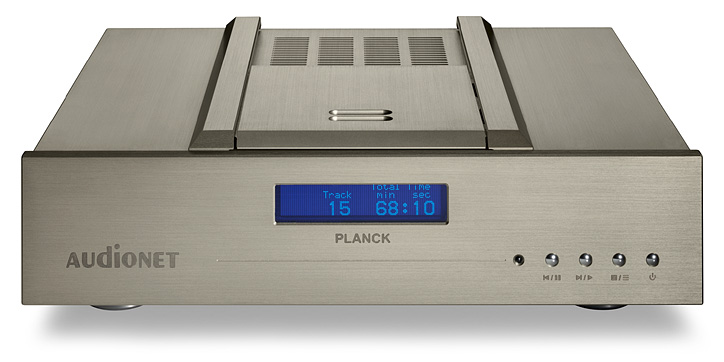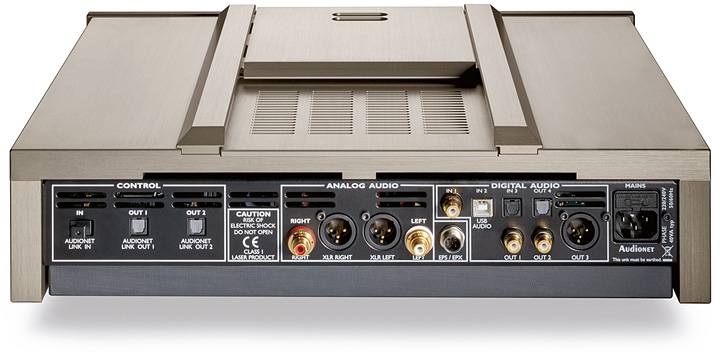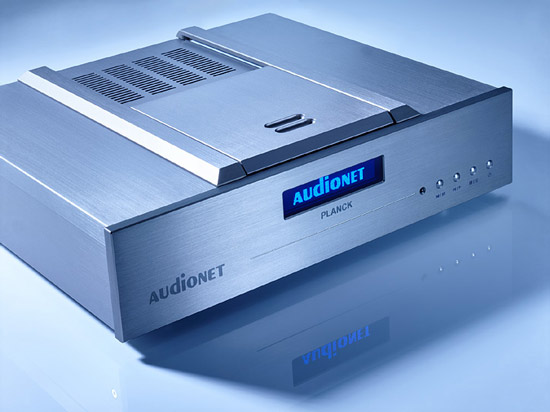
Big shoes to fill: Audionet’s CD player ART G3 has been enthusiastically reviewed in the international press and achieved numerous awards. Many audiophiles consider it as the benchmark, and actually the machine also represented state of the art for Audionet, too. However, at the Munich high-end show, which for the manufacture was a kind of taking breath in between packing their bags in Bochum, Audionet introduced the new CD player Planck. The relocation of their headquarters to the German capitol city is not much of a surprise; much less is the commitment to the compact disc, even regarding their own advances towards network audio. After all the CD has occupied an important place in audiophile’s shelfs over three decades and doesn’t seem to vacate this pole position soon. Moreover CDs still have the largest market share in many countries, despite the increasing significance of high resolution files. In contrast the launch of a new CD player was indeed a bit surprising, given how sophisticated the third generation ART is. Obviously when proclaiming the ART G3 to be Audionet’s final statement at the time of it’s rollout, they referred not to CD reproduction itself being maxed out, but rather to the device concept.
By optimizing the slightest details one can achieve major leads compared with previous model versions, yet sometimes the continuous R&D process requires to make a bigger step. Apparently, for Audionet it had been about time for nothing less but a quantum leap. Consequently the Planck, together with it’s teammates from the brand new scientist series, is part of a large-scale project which fully reflects Audionet’s current technological potential. Sidewards to the CD player there is the integrated amplifier Watt and the external power supply Ampere, which is not intended for the Watt or for both the amplifier and the source. Instead, the Ampere was created exclusively to perfect the player by feeding it’s analogue stages. If the ampere is capable of effecting such an amazing performance gain like the EPX does with the ART G3, remains to be seen. This time, it is all about the Planck, just the way it comes - that alone promises to be a juicy matter.
From an aesthetic point of view one might look upon the Planck as a wary, yet impactful modification of the ART-design. The clear shaping of the case as well as the tidy front side with the proven four-button-approach are familiar parts of its appearance; just like the excellent vacuum fluorescence display, which is clearly readable also from a certain distance. Concerning the finish Audionet dared to make a bold step for the first time: the anodised aluminium parts are available in the colour »light bronze« only. An appealing choice no doubt, as this tone appears classy and shimmers in slightly different nuances, depending on the light incidence. And a wise one too, since there is no accounting for taste, but for design quality: this colour scheme stands out pleasingly from the widespread alternatives to black, like silver or champagne.


The connection options of the Planck are versatile - for him the musical world shall be more than just a disc. In order to function as a D/A converter for other digital sources, it features one coaxial S/PDIF input, one optical TosLink interface and one USB B-type interface, which allows for USB audio 2.0. This input got its technology from the Audionet network sources, it works in asynchronous mode and carries out a complete galvanic isolation with fully separated electric grounds. In addition signals from the USB interface are re-clocked before further processing. The TosLink interface supports data streams up to a resolution of 192 kilohertz / 24 bit as well, although its original definition was only intended for 96 kilohertz - premium receivers make the higher bandwidth possible.
To output digital signals the Planck provides one AES/EBU output, two coaxial S/PDIF outputs and one TosLink interface. These digital outputs can be deactivated, which is a quite rare, but all the more a commendable feature. Thus any interference they may cause, no matter how negligible it seems, can be avoided.
Centre of mass
True connoisseurs like the haptic experience, there is no doubt about this, too. They will particularly appreciate the top-loader drive with a heavy sliding cover, waiting to be handled manually. This drive cover, made from aluminium, offers haptic delight by the kilo and glides in Teflon-coated guide rails as soft as butter. Inserted CDs are fixed rigorously, nevertheless sensitively at the same time: a stabilisation puck provides for appropriate contact pressure, adapting to slightly varying thicknesses of discs with the help of a strong neodymium magnet and a rubber ring. Its diameter is small, thus little mass works outside the rotation axis. The centring of the mass is important, because a bit of space between the shaft and the puck is necessary to put it on smoothly. But exactly this little distance, in combination with tiny irregularities of the CD surface, could cause a minimal incline of the puck which then again results in a tumbling motion of the speedily rotating disc. All this is about differences within a few tenths of a millimetre, but this is just the beginning of Audionet’s perfectionism.
While puristic CD reading units slowly disappear from the market and give way to computer drives in many high-end CD players, Audionet uses a dedicated CD transport for the Planck, namely the Philips CD-PRO2LF. This excellent drive sits on an eight-millimetre-thick basis, which is manufactured from a solid block of aluminium. High mass is favourable here, in order to make the resonance behaviour of the housing design as neutral as possible. Therefore also the case cover, the chassis and the front side are made from this non-ferromagnetic metal, between twelve and twenty millimetres thick. As in the case of the other Audionet players, a heavy ground plate provides for additional dampening, but due to a new resonance tuning concept, the bottom plate inside the Planck is manufactured from slate.


Rocket science
Audionet has always been keen on dealing thoroughly with the issue of mechanical influences, but designing the Planck they went further than ever before: even the fittings of the chassis and the circuit boards have been optimised in terms of resonance control. The »Aligned Resonance Transport«, giving the ART-models their name, is still onboard. This belt suspension isolates the whole drive unit very effectively by allowing moderate, defined mechanical oscillation in the horizontal axes only. In this way, external vibrations that might cause problematic vertical movements are neutralised.
Directly underneath the drive there are small circuit boards, containing the readout electronics, the clock generator and the data preprocessing circuity. The unconventional positioning of the clock generator within the drive unit mainly serves the purpose to protect it from vibrations during its delicate work, which reduces jitter significantly, as chief developer Volker Wischniowski explains. Despite some inherited construction characteristics, one thing is for sure: the Planck is anything but a fourth generation of the ART - actually it represents a completely new development. This new design also incorporates a power supply concept, which is not simply featuring separate supply circuits for analogue and digital sections. As a matter of fact, the drive unit and the converter section are fed by a third, independent supply.
The converter section is equipped with two Analog Devices AD1955, each of these DACs processes the data from one stereo channel. Moreover the analogue signal processing stage and the discrete Class-A output stage, which includes mica capacitors, that are manufactured exclusively for Audionet according to their own specifications, have been newly developed from scratch. Knowing that these sections, besides the converter’s digital periphery, have greater influence on the sonic performance than the DAC itself, the engineers used all their profound knowledge about tonal effects of components. »Also the extremely temperature-stable low-tolerance resistors that we use for the current-to-voltage conversion, are very beneficial,« reports product manager Andreas Sehlhorst, who is also in particular the sensitive »hearing« of the new Berliners, and adds »they originate from laboratory equipment.«

Event horizon
I have listened to the Planck primarily in its function as a CD player, but it also had to proof its qualities as an external D/A converter for other digital sources: via the electrical S/PDIF input with a network client and via the USB input with Audirvana Plus running on a MacBook. Disturbed make the start with their cover of »The Sound of Silence«; after David Draiman has let out his anger about the »silence« full of superficialities, for quite a while this emotional impact just leaves room for one thing: the same wonderful song performed by James Blake. Unfortunately it is only available online, as an excerpt from his BBC radio show with an MP3-sound track. Anyway, that does not harm the chastening effect this outstanding interpretation has, also thanks to the Planck’s sensitive staging.
This pinpoint sophistication creates an immense attractive power, pulling me towards electronic music like a maelstrom. All those tiny, meticulously arranged effects on Yello’s album »Touch«, I know them inside out, not least from intense experiences with the ART G3. Their minute positioning within an almost infinitely extended room seems even more definite than familiar, but another characteristic of the Planck leaves me indeed lost for words after the track »Speechless« by Kruder & Dorfmeister: the Planck performs with pervasive charisma.
Compositions that appear quite one-dimensional on the face of it, reveal all their complexity now, because of the extremely accurate reproduction in terms of micro dynamics and timing. Within Anja Schneider’s »Surrender« the Planck takes up every arch of melody that seems neglected in direct comparisons, uncurtains very subtle sounds and hidden, very very quiet samples, interspersed in the midst of mightily pumping bass lines. It detects rhythmic and tonal threads and weaves them together again, into what they had been in the recording studio: an exceptional masterpiece of techno house, multifaceted and intriguing.
The Planck always lets the listener in on the musical intention, guides him didactically through the opus and far beyond merely cognitive hearing. Surpassing this horizon one falls through the CD’s center hole, right into the music. Now playing »Les Jeux d’eau a la villa d’Este« from Franz Liszt’s »Années de pèlerinage III«, interpreted by Hélène Grimaud, with her very own, easy characteristic. With this striking intensity I had experienced the brilliancy of her performance and how much she is taken up in it only once, in fact during the »Water«-tour last summer. The Planck’s performance is like an event horizon, from which there is no escape. Also time vanishes in it, but that doesn’t matter, since such musical experience is a constructive use of time. However sentimental minds should be warned: it may well be that you have to recollect yourself afterwards.

with Thomas Gessler, managing partner Audionet

i-fidelity.net: Mr. Gessler, Audionet has just moved to Berlin. Didn’t you like Bochum anymore?
Thomas Gessler: For more than twenty years Bochum has been a really good location for us. But during this period of time, the world didn’t stop turning. Berlin has developed into an economical, technological and energetic centre. Today Berlin simply provides better perspectives, with the relocation we have taken account of this development. Audionet is a »capitol city brand« now.
i-fidelity.net: After you had quite taken your time with one or another new development, in May you travelled to the high-end show in Munich with even five new machines. Did you put a road block out of your way?
Thomas Gessler: We have been constantly introducing new techniques and devices to the market. Yet, this has not always been obvious, since we have been very careful regarding the advancement of our product design.
i-fidelity.net: Recently Audionet has been rewarded with the »German Brand Award« by the German Design Council. What does this award mean to you?
Thomas Gessler: We are indeed very proud of it, because this award confirmed our belief that also a small company can get awareness even from people outside its own core business. I do not consider this award as just an acknowledgement of one person or one product, rather it is a recognition of the excellent team performance.
i-fidelity.net: You have been able to get the renowned industrial designer Prof. Hartmut Esslinger enthusiastic about doing the design work for your new reference components »Stern« and »Heisenberg«. Just how did you do that?
Thomas Gessler: After we had been talking in detail, discussing our ideas for the first time, we knew immediately that we will work together. Mr. Esslinger describes us as fanatical – thus people work together, who belong together.
i-fidelity.net: According to some of your competitors physical sound storage media already became obsolete. What induced you to offer a pure CD player?
Thomas Gessler: Oh well, innovation is a slug and certainly not a straight-lined process. Also vinyls had been declared dead after the introduction of the CD, but what did actually happen? Let’s just see how things will turn out for the CD. In my opinion we will witness a renaissance also in this case. You see, I know the sales figures of our CD players, and they are indeed considerable. It is simply naive to assess a situation only from one’s own point of view. There are millions and millions of CDs in the shelfs of potential customers, just waiting to be listened to. And with our players, one can discover them in a completely new way.




Measurements CD player Audionet Planck
Distortions
THD+N: 0,0015 %
IM distortions (SMPTE): 0,0024 %
IM distortions (CCIF): 0,0003 %
Signal-to-noise ratios
Unweighted SNR (20 kHz): -97,9 dBr
Noise voltage (A-weighted): -100,1 dBr
Converter linearity
-50 dB: 0,013 dB
-60 dB: 0,014 dB
-70 dB: 0,017 dB
-80 dB: 0,027 dB
-90 dB: 0,040 dB
Other
Output voltage: 3,57 V
Channel difference: 0,019 dB
Source resistance: 33 Ω
Power consumption
Standby: 1 W
Idle: 21,5 W

Manufacturer: Idektron GmbH & Co. KG, Berlin
Model: Planck
Product category: CD player with D/A converter functionality
Warranty: 3 years (registration required)
Digital inputs: USB-B (USB Audio 2.0), coaxial RCA (S/PDIF), optical TosLink (S/PDIF)
Analogue outputs: RCA, XLR
Digital outputs: 2 x coaxial RCA (S/PDIF), optical TosLink (S/PDIF), AES/EBU
Remote control RC1
Audionet Link in (optical TosLink)
2 x Audionet Link out (optical TosLink)
Optional: external power supply Ampere
Delivery contents: remote control RC1, user manual, power cord, warranty card
Finishes: Aluminium anodised, colour light bronze
Dimensions (W x H x D): 43 x 12 x 37 cm (16.9 x 4.7 x 14,5 in)
Net weight: 25 kg (55.1 lbs)

Idektron / Audionet
Unternehmens- und Technologieberatung GmbH & Co.
Entwicklungs- und Produktions-KG
Alboinstraße 36-42
12103 Berlin
Germany
Phone: (+49) 30 / 23 32 42 10
Internet: www.audionet.de
Facebook: https://www.facebook.com/audionet.international/?fref=ts


Audionet is focusing on PCM, but they offer much more with the Planck than just a pure CD player: thanks to a S/PDIF input, a TosLink interface and an USB audio 2.0 input every relevant kind of digital source can benefit from the sound quality of the Planck’s converter. In addition with one AES/EBU, two S/PDIF and one TosLink there are more than enough digital outputs, which also can be deactivated.
Yet the Planck isn’t about features but perfecting one function, for one single purpose: pure musical enjoyment with CDs and other digital sources. Audionet has nurtured great expectations in this case - and comes up to them to fullest extend. The Planck is characterized to the core by exceptional musicality - playing inconceivably relaxed, also with dedicated precision and an ear-piercing, inspiring charisma. Marius Donadello
| Audionet Planck |
| Warranty: three years after registration |
- Sound quality
- superb
- Laboratory
- very good
- Features
- very good
- Workmanship
- outstanding
- Overall score
- superb

TEST
- :
- Audionet Planck
- Author:
- Marius Donadello
- Date:
- 13.07.2016
- Manufacturer:
- Audionet

